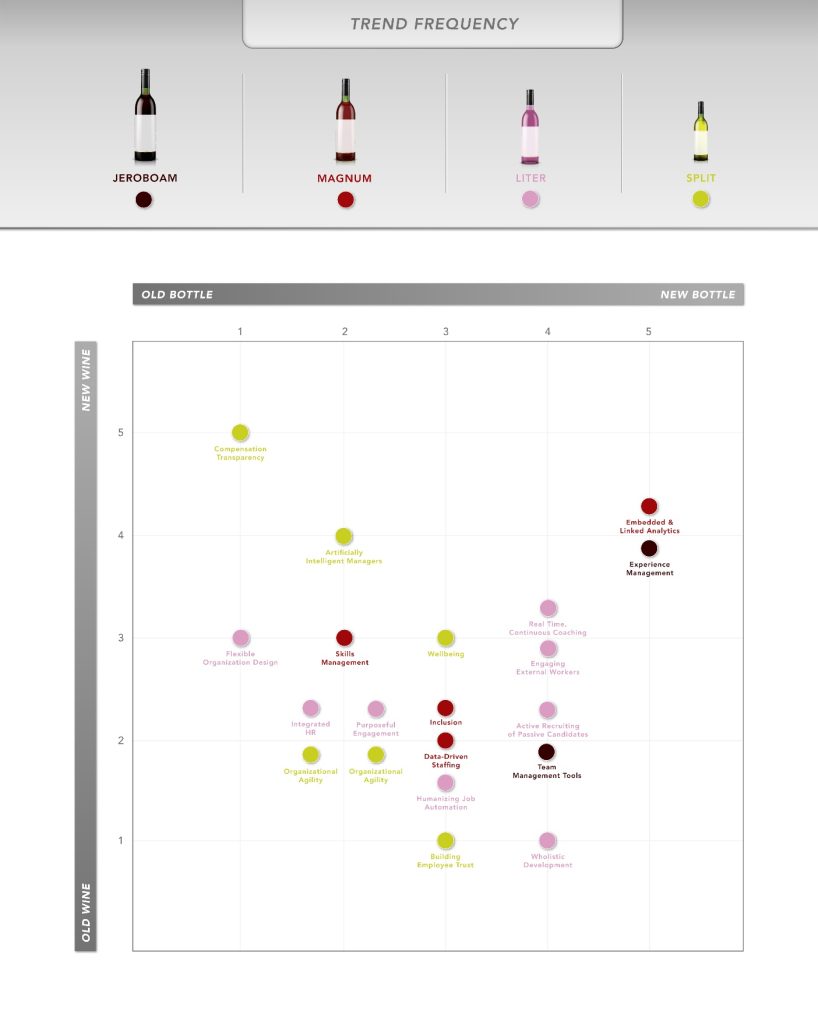Every year I read through hundreds of human capital management (HCM) forecasts, trends and predictions to see if there is anything truly new on the horizon. A few years ago, Lauren Bidwell and I started categorizing these predictions into something we call the “Wine Bottle Index” (WBI). We gather predictions from HR thought leaders, consulting firms, and industry associations published in articles with titles like “10 things in HCM to watch for,” “3 major changes affecting HR,” or “the top 5 talent management trends.” We then categorize the predictions based on similar themes and rate them based on whether they address well-established vs. novel challenges (old vs. new wine) and involve use of familiar vs. innovative solutions (old vs. new bottles).
The first review was completed in 2016 and categorized 131 predictions from 20 articles. The 2017 review categorized 130 predictions and observations from 21 articles and introduced the “wine bottle index” (WBI). The 2018 study summarized 176 predictions from 29 articles. This year we identified 176 predictions from 23 articles, falling into 19 general categories. The illustration summarizes the results of the WBI ratings. The full study can be found here including a comparison of this year’s predictions with predictions from previous years.
Here are some of the more interesting findings from this year’s study:
“Experience Management” and “Team Management” are the hot topics of 2019 — Most forecasts highlighted the need to provide employees with simpler, more enjoyable work environments, as well as the need to provide better tools to support agile, dynamic teams. These trends are some of the newest changes to emerge since we started compiling the WBI in 2016. To be clear, there is nothing new about “work experience” or “team management.” What is new however, is how companies are defining these concepts, the focus being placed on them, and the solutions being developed to address them.
Artificial Intelligence and Machine Learning (AI/ML) are still present but less prominent — Increased use of AI/ML was the dominant trend in 2018. In 2019 the trend is still mentioned, but usually in the context of predictions around the development of Embedded Analytics in HCM processes and deployment of data driven staffing methods. In sum, AI/ML are starting to be viewed as simply another tool, albeit a powerful one, that companies use to enable automation and interpret data.
Cooperating instead of competing with job automation — Many forecasts discussed the need to help employees adapt to the digitalization of work. Predictions related to “Skills Management,” “Wholistic Development,” and “Job Automation” were all discussed in the context of helping employees co-exist with work technology. This is a shift from previous years when predictions often focused more on employees being entirely replaced by automation.
Skills management is starting to reach a critical level — People have been discussing the growing skills shortage for years. Yet companies struggle to identify, track and develop skills within their organizations at even very basic levels. Based on this year’s forecasts, this may finally change. But it will require more innovation before we have technology that truly does skills management justice.
Imagine a world where everyone knows how much everyone else is paid — A relatively small but potentially transformational forecast is the shift toward total transparency around compensation. Pay data is becoming increasingly public as a result of regulations requiring companies to demonstrate pay equity and use of online sites where employees can publicly share and review pay levels. This means companies will come under increasing pressure to explain why they pay some employees more than others.
